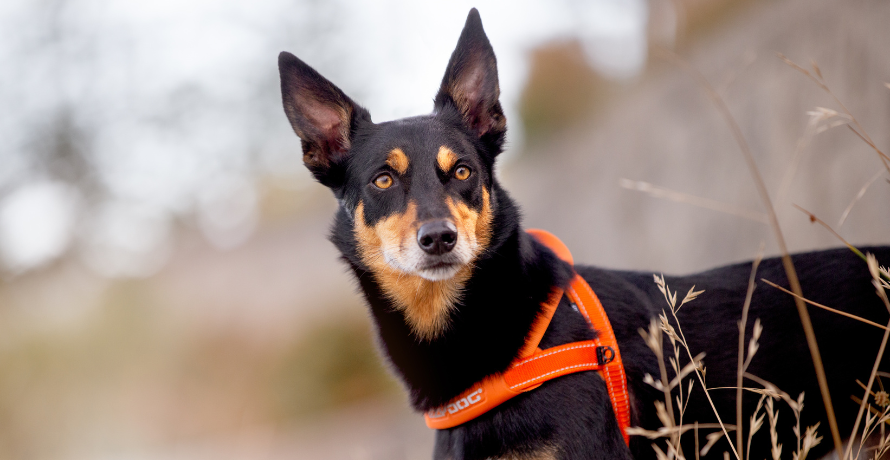
Best Dog Harnesses for Hiking: Loved by UK Dog Owners
Hiking with your pup is great excerise and with the right gear, it can safe, fun and a great bonding experience. The right harnesses keep pressure off your dogs neck, give you confident handling, and stay comfortable whatever the distance.
Below are seven EzyDog Harness options picked for UK trails, chosen for control, comfort, and easy fit. You can also browse our whole range of Dog Harnesses here.
1. Convert™ Harness
For the trail walker who wants versatility and adaptability, the Convert Harness is a top hiking choice. Its multi-clip points let you easily switch between front and back leash attachments, depending on whether your dog is pulling, traversing steep climbs, or walking on level terrain. The padded design and adjustable straps ensure a snug, comfortable fit, so your dog stays stable and secure even over uneven ground. When paired with proper gear, the Convert Harness is ideal for long hiking days in the countryside.
Best for:Dog owners who want a versatile hiking harness that adapts to changing terrain with multi-clip leash options.

2. X-Link No-Pull Harness
The X-Link harness is designed for dual functionality, which makes it a strong contender for hiking routes where conditions change. You can switch between the back clip for casual walking and front clip for better control on inclines or tricky terrain. This flexibility is especially helpful for dogs that vary their pulling behaviour depending on the path. Its durable hardware and rugged build also stand up well to mud, brush, and wetter environments found.
Best for:Dogs that need front-clip no-pull control on steep hikes and a back clip for relaxed trail walking.

3. Express Harness
The Express harness works well on hikes where lightweight and quick application are key. Its padding helps buffer the dog’s chest during repetitive motion, and the quick-fit design ensures you can clip on fast when you need to get moving or adjust on the go. For hikes that include stops, streams, or sudden pace changes, Express gives you the convenience and comfort you need.
Best for:Hikers who need a lightweight, easy-on harness for quick transitions and comfortable all-day wear.

4. Quick Fit Dog Harness
The Quick Fit one-click buckle system means minimal struggle when fitting it in cold or low-light conditions (common on hillsides or forested paths). The padded chest and soft webbing reduce rubs or discomfort over long walks. For terrain with changing conditions, Quick Fit’s ease and comfort become major advantages.
Best for:Owners who want a one-click hiking harness that’s simple to use, padded, and secure on UK trails.

5. Chest Plate Harness
On narrow ridges, steep declines, or bushy trails, the Chest Plate harness won't dissapoint. Its contoured EVA foam chest plate helps the harness hold its shape and resist twisting, so your dog remains secure. The design also allows for better chest coverage and protection against awkward branches. Reflective stitching helps visibility on longer dark evenings, and the sturdy build handles strenuous hikes without sacrificing comfort.
Best for:Dogs that need secure hiking harness with added chest protection on rough terrain.

6. Cross Check Harness
If your dog is working on their hiking manners, the Crosscheck harness gives you a lightweight training tool on the trails. As a figure-8 style “limited slip” harness, it gives a gentle correction when your dog pulls, helping discourage bad habits over time. Because it’s minimal in structure, it doesn’t impede movement, important when navigating rocks or narrow footpaths. Use it in tandem with patient training, especially on multi-hour hikes.
Best for:Training dogs on hikes who pull, a lightweight no-pull hiking harness that encourages polite walking.

7. Summit BackPack
No hiking gear list is complete without the Summit Backpack, a dog pack harness that lets your pet carry their own supplies (water, snacks, collapsible bowls). This backpack combines utility with comfort: contoured panels, padded straps, and reinforced buckles keep the load balanced and secure during long treks. For longer day hikes in the UK, using the Summit Backpack relieves your load while keeping essentials handy on your canine companion.
Best for:Active dogs and owners who want a hiking backpack harness
so pets can carry their own snacks, and gear.
Shop Summit BackPack | Browse Backpacks Collection

How to choose a hiking harness (quick, practical)
Keep it simple: you’re looking for a stable fit, easy control, and all-day comfort.
- Fit that doesn’t budge: multiple adjustment points stop the harness twisting when your dog changes direction.
- Control where you need it: a front clip (built-in or via the UpFront D-Ring) gives gentle steering on narrow paths; a back clip is relaxed for wider tracks.
- Comfort for miles: padded contact zones, a non-restrictive Y-front, and reflective accents for low-light valleys and winter afternoons.
Pair your harness with trail-friendly leads: Road Runner Leadfor hands-free sections, or a Zero Shock Lead to soften sudden pulls on descents.
Measuring, fitting & staying safe on UK trails
A good fit is half the battle. Measure chest girth at the widest point behind the front legs; pick the size where that measurement sits mid-range on the chart. Adjust each strap evenly and aim for a snug two-finger gap under every strap. Re-check after coat or weight changes.
A few UK-specific notes:
- Use leads around livestock and on signed stretches; give wildlife and other walkers space
- Add ID and reflective touches; weather and light can change quickly
- Bring water and a rest plan — dogs overheat faster than we do, even on windy days
Common Concerns from UK Dog Owners
Are hiking harnesses different from walking harnesses?
They’re built with the same comfort principles, but hiking picks tend to prioritise stability, grab-handles, and durable materials that cope with mud and kit rubbing. Many owners happily use one well-fitted harness for both city and trail, just look for the features above.
Should a hiking harness have a handle?
It’s not mandatory, but a handle is extremely useful for helping your dog over stiles, lifting into a car boot, or steadying them on steep rock steps. The Convert is a popular choice if you want that planted feel plus a handle.
Can my dog carry a backpack?
Yes - lightly. Start with tiny loads (water, bowl) and build up slowly, keeping the experience positive. Skip weight-carrying for puppies, seniors, and dogs with health concerns; when in doubt, keep it light and ask your vet.
Will a harness stop pulling on its own?
Think of it as power steering. A front-clip or dual-clip design makes neat lead manners much easier to teach, but progress comes from short, positive sessions and consistency on every walk.
Insights & tips from UK Dog Owners
Hiking here is a mix of bridleways, stiles, stone steps, muddy fields and quick weather shifts — so little tweaks make a big difference.
- Use front-clip on narrow paths. When the trail pinches or you’re passing other walkers, clip to the chest ring (or fit the UpFront D-Ring) for gentle steering and tidier heelwork. Switch back to the top ring on wider tracks.
- Handles are worth their weight. A back handle (e.g., on the Convert) is brilliant for boosting over stiles, steadying on rock steps, and guiding into the car boot without grabbing a collar.
- Hands-free on steady sections. A road-runner style lead keeps your arm relaxed and your footing balanced on long inclines. Swap to a standard lead for technical ground.
- Keep loads light (if using a pack). Start with nearly nothing in a Summit Backpack, let your dog enjoy it, then creep the weight up slowly across a few short walks. Comfort first; enthusiasm second; weight third.
- Layer smart in wet weather. If your dog wears a lightweight coat, fit the harness under the shell (if the coat allows harness access) so straps don’t rub when soaked.
- Do quick “field checks”. Every water stop, run fingers under the chest/shoulder straps, check for grit under the harness, and re-snug after a big shake.
- End-of-walk routine. Rinse mud off contact areas, pat dry, and check paws (thorns, grit between toes). A 30-second once-over prevents next-day rubs.
- Country etiquette. Keep your dog close around livestock and ground-nesting birds; follow local signage and give everyone plenty of space on popular routes.
Common mistakes to avoid
These are the little gotchas that tend to unravel otherwise good walks — plus how to fix them.
- Relying on a back-clip only with pullers. On exciting trails it can power dogs forward. Fix: Use a front-clip or dual-clip setup for steering on tight sections.
- Loose or drifting fit. Straps “bed in” and coats flatten on the move. Fix: Re-check tension after 10 minutes and after any big shake; aim for a snug two-finger gap under each strap.
- Skipping acclimation to backpacks. Loading up on day one is a fast track to souring the experience. Fix: Start almost weightless and build gradually
- Retractable leads on single-track. They tangle on brambles and trip walkers. Fix: Use a fixed-length lead; keep it short and relaxed by your side when the path narrows.
- Not adjusting for seasons. A winter coat or summer clip changes fit. Fix: Re-measure girth when coat thickness changes and tweak strap lengths accordingly.
- Ignoring small comfort cues. Head-tilts, persistent scratching, or a harness that creeps up towards the throat are all signals. Fix: Pause, readjust, remove grit, and only then carry on.
- Forgetting visibility. Dusk comes quickly in the hills. Fix: Reflective trim (and a small clip-on light) makes a real difference on the walk out.
Final Thoughts
For UK hiking, pick a harness that fits securely, gives confident handling, and stays comfortable on long outings, add a front clip (built-in or with UpFront D-Ring) if you want extra control on narrow paths.
Our cheat sheet: Use the Convert for extra security; X-Link for very strong or large dogs; Express or Quick Fit for lightweight, everyday adventures; Chest Plate if you want cushioned stability; Summit Backpack if your pup is happy to carry a little kit.





